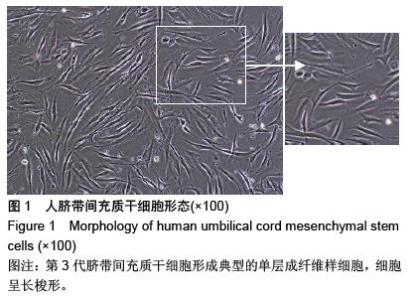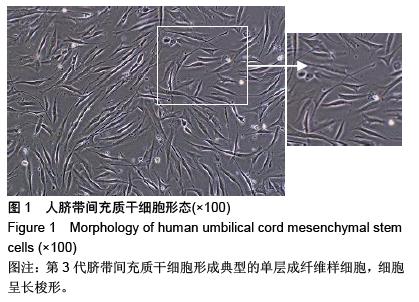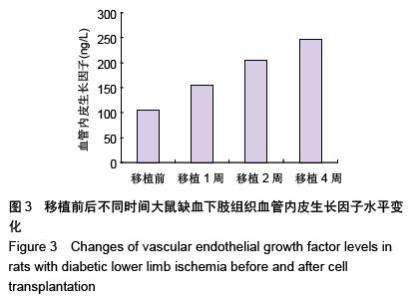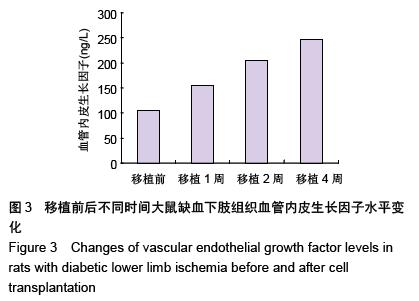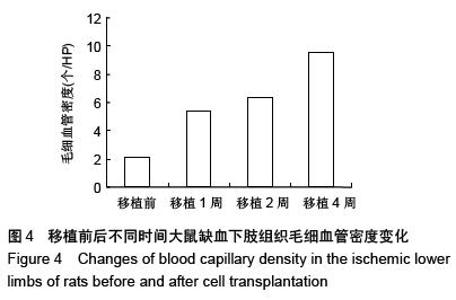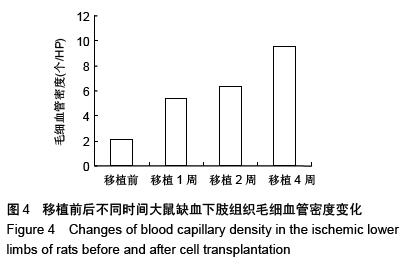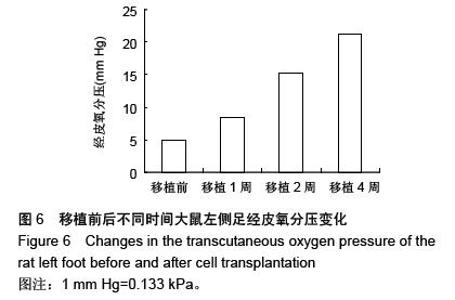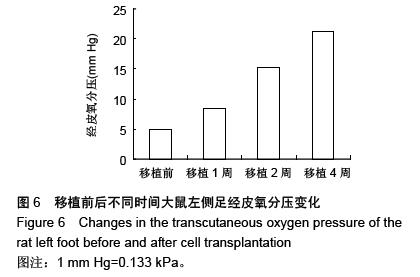Chinese Journal of Tissue Engineering Research ›› 2016, Vol. 20 ›› Issue (1): 78-82.doi: 10.3969/j.issn.2095-4344.2016.01.014
Previous Articles Next Articles
Feasibility of umbilical cord blood stem cell transplantation for the treatment of diabetic lower limb ischemia
Xie Li-hua1, Xing Lin2, Zheng Hang3
- 1Affiliated Central Hospital of Xinxiang Medical University, Xinxiang 453000, Henan Province, China; 2Cell Research Center, Zhengzhou University Medical School, Zhengzhou 450001, Henan Province, China; 3Third Affiliated Hospital of Xinxiang Medical University, Xinxiang 453003, Henan Province, China
-
Received:2015-11-29Online:2016-01-01Published:2016-01-01 -
Contact:Xing Lin, Professor, Cell Research Center, Zhengzhou University Medical School, Zhengzhou 450001, Henan Province, China -
About author:Xie Li-hua, Attending physician, Affiliated Central Hospital of Xinxiang Medical University, Xinxiang 453000, Henan Province, China
CLC Number:
Cite this article
Xie Li-hua, Xing Lin, Zheng Hang. Feasibility of umbilical cord blood stem cell transplantation for the treatment of diabetic lower limb ischemia[J]. Chinese Journal of Tissue Engineering Research, 2016, 20(1): 78-82.
share this article
| [1] 张弛,肖日军,张娜,等.脐血干细胞移植治疗糖尿病大鼠下肢缺血的实验研究[J].中华损伤与修复杂志:电子版,2012,7(1):18- 23.
[2] 马红芳,王富军.脐血干细胞移植及血管成形治疗糖尿病下肢缺血性疾病[J].中国组织工程研究,2015,19(23):3755-3760.
[3] 杨华强,李东升,杜玲,等.脐血干细胞移植在糖尿病足治疗中的应用:附二例报告[J].中国全科医学,2010,13(23):2551-2553.
[4] 郑曦,肖日军,张弛,等.静脉输注人脐血干细胞移植治疗糖尿病大鼠下肢缺血的实验研究[C].中华医学会第九次全国内分泌学学术会议论文集,2010:278.
[5] Oda M, Toba K, Ozawa T, et al. Establishment of culturing system for ex-vivo expansion of angiogenic immature erythroid cells, and its application for treatment of patients with chronic severe lower limb ischemia.J Mol Cell Cardiol. 2010;49(3):347-353.
[6] 张亚萍,陶松桔,宋卫红,等.脐血干细胞移植治疗糖尿病足的临床观察[J].中国临床研究,2012,25(3):218-220.
[7] Lu D, Chen B, Liang Z, et al. Comparison of bone marrow mesenchymal stem cells with bone marrow-derived mononuclear cells for treatment of diabetic critical limb ischemia and foot ulcer: a double-blind, randomized, controlled trial. Diabetes Res Clin Pract. 2011;92(1):26-36.
[8] 黄蓉,夏宁,梁瑜祯,等.干细胞移植治疗下肢缺血性疾病的研究进展[J].中国组织工程研究与临床康复,2007,11(7):1305-1308.
[9] Shen WC, Liang CJ, Wu VC, et al. Endothelial progenitor cells derived from Wharton's jelly of the umbilical cord reduces ischemia-induced hind limb injury in diabetic mice by inducing HIF-1α/IL-8 expression. Stem Cells Dev. 2013;22(9): 1408-1418.
[10] Taneja M, Tay KH, Dewan A, et al. Bare nitinol stent enabled recanalization of long-segment, chronic total occlusion of superficial femoral and adjacent proximal popliteal artery in diabetic patients presenting with critical limb ischemia. Cardiovasc Revasc Med. 2010;11(4):232-235.
[11] Powell RJ, Goodney P, Mendelsohn FO, et al. Safety and efficacy of patient specific intramuscular injection of HGF plasmid gene therapy on limb perfusion and wound healing in patients with ischemic lower extremity ulceration: results of the HGF-0205 trial. J Vasc Surg. 2010;52(6):1525-1530.
[12] 杨华强,李东升,杜玲,等.脐血间充质干细胞移植治疗糖尿病足二例并文献复习[J].中国综合临床,2010,26(9):918-920.
[13] 肖日军,张弛,李华珠,等.人脐血干细胞移植治疗糖尿病大鼠下肢缺血的实验研究[C].中华医学会第九次全国内分泌学学术会议论文集,2010:544.
[14] 张会峰,赵志刚.内皮祖细胞及其治疗下肢缺血疾病的研究进展[J].实用诊断与治疗杂志,2005,19(4):270-272.
[15] 于凤泉,李群,李富元,等.血管重建治疗糖尿病缺血性血管病变对血管内皮生长因子及内皮素的影响[J].中国现代医药杂志, 2014,16(1):48-50.
[16] 刘小银.UCMSCs和ECFCs在糖尿病小鼠下肢血管病变中的成血管作用[D].长沙:中南大学,2013.
[17] 朱旅云,王广宇,马利成,等.脐血单个核细胞移植治疗糖尿病足23例[J].中国组织工程研究,2012,16(1):175-178.
[18] Oda M, Toba K, Ozawa T, et al. Establishment of culturing system for ex-vivo expansion of angiogenic immature erythroid cells, and its application for treatment of patients with chronic severe lower limb ischemia.J Mol Cell Cardiol. 2010;49(3):347-353.
[19] 谷涌泉,郭连瑞.干细胞移植技术在下肢缺血中的应用[J].中华医学信息导报,2004,19(20):14.
[20] 杜丽苹,李彦州,温志国,等.干细胞移植术治疗慢性下肢动脉闭塞性疾病91例研究报告[J].中医临床研究,2010,2(15):85.
[21] 谷涌泉.自体干细胞移植治疗下肢缺血性疾病的问题和对策[J].外科理论与实践,2009,14(3):269-270.
[22] 徐燕,李云涛,李长虹,等.脐血来源多能成体祖细胞体内外内皮分化潜能及细胞移植改善下肢缺血的研究[C].第11次中国实验血液学会议论文集,2007:302-303.
[23] 刘珍珍.脐血内皮祖细胞糖基化修饰及其在缺血性动物模型的应用[D]. 苏州:苏州大学,2013.
[24] Finney MR, Greco NJ, Haynesworth SE, et al. Direct comparison of umbilical cord blood versus bone marrow-derived endothelial precursor cells in mediating neovascularization in response to vascular ischemia. Biol Blood Marrow Transplant. 2006;12(5):585-593.
[25] 孙晟轩.人脐血内皮祖细胞糖基化修饰及其在骨折修复中的作用及机制研究[D]. 苏州:苏州大学,2014.
[26] 李茂,黄文.自体干细胞移植治疗严重下肢缺血[J].中国组织工程研究,2013,17(49):8602-8607.
[27] Faglia E, Clerici G, Airoldi F, et al. Revascularization by angioplasty of type D femoropopliteal and long infrapopliteal lesion in diabetic patients with critical limb ischemia: are TASC II recommendations suitable? A population-based cohort study. Int J Low Extrem Wounds. 2012;11(4):277-285.
[28] 樊国华.干细胞移植干预下肢缺血性疾病[J].中国组织工程研究与临床康复,2007,11(50):10154-10156.
[29] 谷涌泉,张建,齐立行,等.自体骨髓干细胞和外周血干细胞移植治疗下肢缺血的对比研究[J].中国修复重建外科杂志,2007,21(7): 675-678.
[30] 谷涌泉,郭连瑞,张建,等.自体干细胞移植治疗下肢缺血[J].临床外科杂志,2006,14(5):318-320.
[31] Zafarghandi MR, Ravari H, Aghdami N, et al. Safety and efficacy of granulocyte-colony-stimulating factor administration following autologous intramuscular implantation of bone marrow mononuclear cells: a randomized controlled trial in patients with advanced lower limb ischemia.Cytotherapy. 2010;12(6):783-791.
[32] Powell RJ, Comerota AJ, Berceli SA, et al. Interim analysis results from the RESTORE-CLI, a randomized, double-blind multicenter phase II trial comparing expanded autologous bone marrow-derived tissue repair cells and placebo in patients with critical limb ischemia. J Vasc Surg. 2011;54(4): 1032-1041.
[33] 李翠芳,姚远.脐血干细胞移植2型糖尿病下肢血管病变患者内皮依赖性血管舒张的变化[J].中国组织工程研究,2014,18(50): 8098-8102.
[34] Biotteau E, Mahe G, Rousseau P, et al. Transcutaneous oxygen pressure measurements in diabetic and non-diabetic patients clinically suspected of severe limb ischemia: a matched paired retrospective analysis. Int Angiol. 2009;28(6): 479-483.
[35] 杨耀国.人脐带血干细胞移植治疗糖尿病鼠下肢缺血的研究[D]. 北京:北京协和医学院,2009.
[36] 谷涌泉,张建,汪忠镐,等.自体干细胞移植治疗下肢缺血临床转化的现状与未来发展[J].转化医学研究:电子版,2014,4(4):118- 122.
[37] Mohammadzadeh L, Samedanifard SH, Keshavarzi A, et al. Therapeutic outcomes of transplanting autologous granulocyte colony-stimulating factor-mobilised peripheral mononuclear cells in diabetic patients with critical limb ischaemia. Exp Clin Endocrinol Diabetes. 2013;121(1):48-53.
[38] 谷涌泉,郭连瑞.干细胞移植技术治疗下肢缺血的临床应用和未来发展[C].全国血管性疾病介入新技术研讨会论文集,2006: 134-138. |
| [1] | Jiang Tao, Ma Lei, Li Zhiqiang, Shou Xi, Duan Mingjun, Wu Shuo, Ma Chuang, Wei Qin. Platelet-derived growth factor BB induces bone marrow mesenchymal stem cells to differentiate into vascular endothelial cells [J]. Chinese Journal of Tissue Engineering Research, 2021, 25(25): 3937-3942. |
| [2] | Chen Yang, Huang Denggao, Gao Yuanhui, Wang Shunlan, Cao Hui, Zheng Linlin, He Haowei, Luo Siqin, Xiao Jingchuan, Zhang Yingai, Zhang Shufang. Low-intensity pulsed ultrasound promotes the proliferation and adhesion of human adipose-derived mesenchymal stem cells [J]. Chinese Journal of Tissue Engineering Research, 2021, 25(25): 3949-3955. |
| [3] | Zhang Lishu, Liu Anqi, He Xiaoning, Jin Yan, Li Bei, Jin Fang. Alpl gene affects the therapeutic effect of bone marrow mesenchymal stem cells on ulcerative colitis [J]. Chinese Journal of Tissue Engineering Research, 2021, 25(25): 3970-3975. |
| [4] | Ruan Guangping, Yao Xiang, Liu-Gao Miyang, Cai Xuemin, Li Zian, Pang Rongqing, Wang Jinxiang, Pan Xinghua. Umbilical cord mesenchymal stem cell transplantation for traumatic systemic inflammatory response syndrome in tree shrews [J]. Chinese Journal of Tissue Engineering Research, 2021, 25(25): 3994-4000. |
| [5] | Mo Jianling, He Shaoru, Feng Bowen, Jian Minqiao, Zhang Xiaohui, Liu Caisheng, Liang Yijing, Liu Yumei, Chen Liang, Zhou Haiyu, Liu Yanhui. Forming prevascularized cell sheets and the expression of angiogenesis-related factors [J]. Chinese Journal of Tissue Engineering Research, 2021, 25(22): 3479-3486. |
| [6] | Chen Lei, Zheng Rui, Jie Yongsheng, Qi Hui, Sun Lei, Shu Xiong. In vitro evaluation of adipose-derived stromal vascular fraction combined with osteochondral integrated scaffold [J]. Chinese Journal of Tissue Engineering Research, 2021, 25(22): 3487-3492. |
| [7] | Wei Qin, Zhang Xue, Ma Lei, Li Zhiqiang, Shou Xi, Duan Mingjun, Wu Shuo, Jia Qiyu, Ma Chuang. Platelet-derived growth factor-BB induces the differentiation of rat bone marrow mesenchymal stem cells into osteoblasts [J]. Chinese Journal of Tissue Engineering Research, 2021, 25(19): 2953-2957. |
| [8] | Chen Xiao, Guo Zhi, Chen Lina, Liu Xuanyong, Zhang Yihuizhi, Li Xumian, Wang Yueqiao, Wei Liya, Xie Jing, Lin Li. Factors affecting the mobilization and collection of autologous peripheral blood hematopoietic stem cells [J]. Chinese Journal of Tissue Engineering Research, 2021, 25(19): 2958-2962. |
| [9] | Guo Zhibin, Wu Chunfang, Liu Zihong, Zhang Yuying, Chi Bojing, Wang Bao, Ma Chao, Zhang Guobin, Tian Faming. Simvastatin stimulates osteogenic differentiation of bone marrow mesenchymal stem cells [J]. Chinese Journal of Tissue Engineering Research, 2021, 25(19): 2963-2968. |
| [10] | Li Congcong, Yao Nan, Huang Dane, Song Min, Peng Sha, Li Anan, Lu Chao, Liu Wengang. Identification and chondrogenic differentiation of human infrapatellar fat pad derived stem cells [J]. Chinese Journal of Tissue Engineering Research, 2021, 25(19): 2976-2981. |
| [11] | Gao Yuanhui, Xiang Yang, Cao Hui, Wang Shunlan, Zheng Linlin, He Haowei, Zhang Yingai, Zhang Shufang, Huang Denggao. Comparison of biological characteristics of adipose derived mesenchymal stem cells in Wuzhishan inbreed miniature pigs aged two different months [J]. Chinese Journal of Tissue Engineering Research, 2021, 25(19): 2988-2993. |
| [12] | Cao Yang, Zhang Junping, Peng Li, Ding Yi, Li Guanghui. Isolation and culture of rabbit aortic endothelial cells and biological characteristics [J]. Chinese Journal of Tissue Engineering Research, 2021, 25(19): 3000-3003. |
| [13] | Dai Min, Wang Shuai, Zhang Nini, Huang Guilin, Yu Limei, Hu Xiaohua, Yi Jie, Yao Li, Zhang Ligang. Biological characteristics of hypoxic preconditioned human amniotic mesenchymal stem cells [J]. Chinese Journal of Tissue Engineering Research, 2021, 25(19): 3004-3008. |
| [14] | Qin Yanchun, Rong Zhen, Jiang Ruiyuan, Fu Bin, Hong Xiaohua, Mo Chunmei. Chinese medicine compound preparation inhibits proliferation of CD133+ liver cancer stem cells and the expression of stemness transcription factors [J]. Chinese Journal of Tissue Engineering Research, 2021, 25(19): 3016-3023. |
| [15] | Dai Yaling, Chen Lewen, He Xiaojun, Lin Huawei, Jia Weiwei, Chen Lidian, Tao Jing, Liu Weilin. Construction of miR-146b overexpression lentiviral vector and the effect on the proliferation of hippocampal neural stem cells [J]. Chinese Journal of Tissue Engineering Research, 2021, 25(19): 3024-3030. |
| Viewed | ||||||
|
Full text |
|
|||||
|
Abstract |
|
|||||
